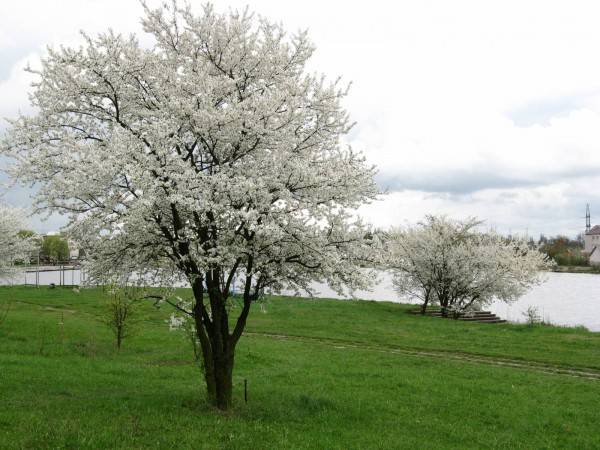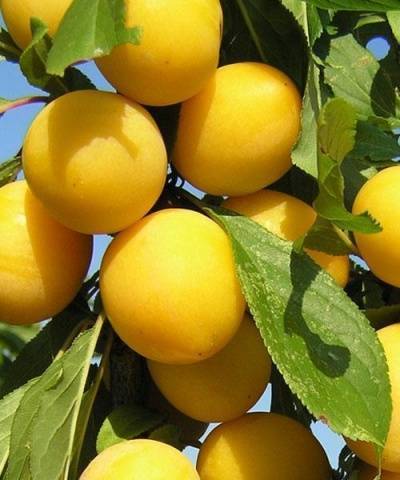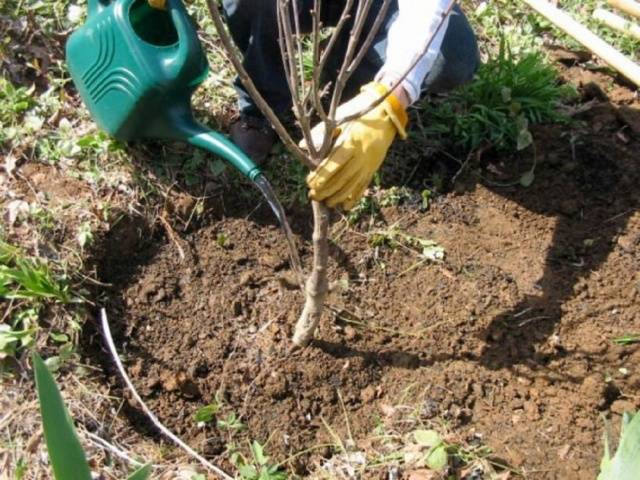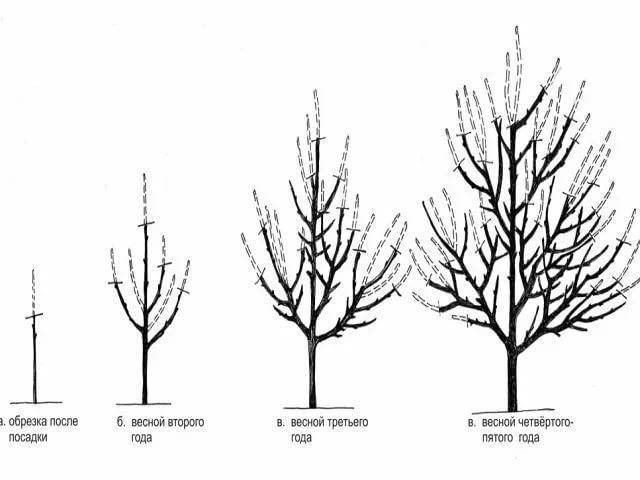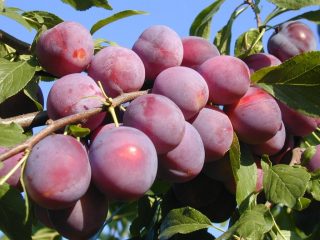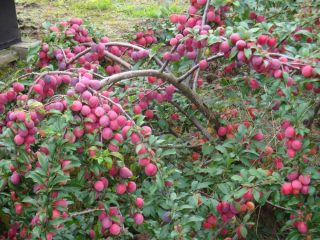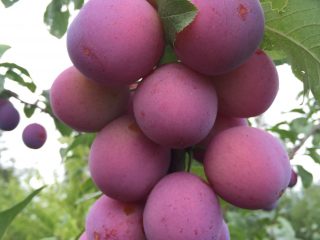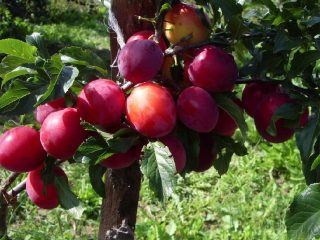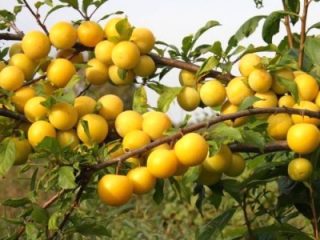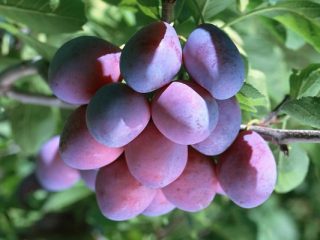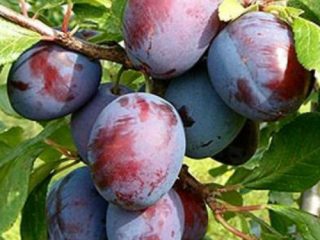Content
Cherry plum Mara is one of the popular varieties of large-fruited plums, characterized by late ripening. The culture grows in central regions, tolerates low temperatures favorably and is quite resistant to various diseases of fungal or viral origin.
History of selection
The Mara variety was bred in the late 80s of the 20th century by cross-pollinating garden cherry plums and Chinese plum by scientists from Belarus. The main work was carried out by such breeders as V. A. Matveeva, M. G. Maksimenko and others. The variety was introduced into the State Register of the Russian Federation in 2002.
Description of culture
This plum variety is characterized by fairly large dimensions. The height of the Mara cherry plum tree by the 4-5th year of life can reach 3-3.5 meters. The crown is spreading, most often spherical in shape, with a diameter of about 2.5-2.7 meters. The tree grows especially quickly in the first years after planting.
For clarity, below is a photo of Mara cherry plum. As you can see, the bark of the cherry plum is dark brown; on young shoots it has a slightly reddish tint. The root system is well developed. The leaves are oval, slightly elongated and rich green in color. The flowers are white, numerous.
The description of the Russian plum (Mara cherry plum) also includes the characteristics of the fruit. The fruit is bright yellow, round in shape, large and fleshy, the weight of one plum is about 25 g. The pit is difficult to separate from the pulp.
Mara plum can be grown both in the southern regions and in the regions of central Russia.
Characteristics
A distinctive feature of this crop from other plum varieties, most often grown in the south, is its high frost resistance and resistance to pests and diseases. This is why the Mara cherry plum feels great in the Moscow region and other central regions.
Drought resistance, winter hardiness
The main characteristic of the Maara cherry plum variety is winter hardiness. The culture can tolerate temperatures down to – 35-37 °C.
Drought resistance is average. During long periods without precipitation, the plant must be provided with proper watering.
Pollination, flowering period and ripening time
The plum variety is self-sterile, so pollinators for Mara cherry plum are needed to obtain a harvest. First of all, these are other plum varieties that have similar flowering periods, for example, Vitba.
Flowering occurs quite late - at the end of April or beginning of May. The period of fruit ripening occurs in the third decade of August or even at the beginning of September. These terms depend on the region where the crop is grown and the climatic conditions.
Productivity, fruiting
The high yield of Mara cherry plum is one of the main advantages of the variety.Starting from the third year after planting, about 37-40 kg of juicy and ripe fruits can be collected from each mature tree. Maximum fruiting begins around the 7th year of life, then the harvest can reach more than 60 kg.
Area of application of fruits
The fruits of this plum variety have excellent taste, and reviews of Mara cherry plum are the main confirmation of this fact. According to the tasting assessment, the fruits receive 4.2 points out of a maximum of 5. The pleasant aroma and sweet and sour taste allow the plum to be used for preparing compotes, various sauces, as well as for making preparations for the winter.
Resistance to diseases and pests
The Mara variety has quite high resistance to fungal or viral diseases, as well as pests. Regular preventive measures allow you to avoid any contamination of the crop for a long time.
Advantages and disadvantages
The main strengths of the Mara variety are:
- high productivity;
- large fruit;
- winter hardiness and drought resistance;
- immunity to many diseases and resistance to pests;
- excellent taste of the fruit.
The weaknesses of culture are:
- self-sterility;
- late periods of flowering and fruiting.
Despite these minor drawbacks, the Mara plum is still considered one of the best crops suitable for growing in regions with cold and unstable climates.
Landing Features
Growing Mara cherry plum has a number of its own characteristics, the observance of which is necessary to obtain a rich harvest and ensure the successful growth of the plant.
Recommended timing
Plum trees are usually planted in the spring. It is during this period that the risks of freezing of the root system or damage to shoots are minimized.
Choosing a suitable location
Cherry plum is a light-loving crop, so for planting it is best to choose the southern or southwestern side of the site with some kind of structure or fencing from the north winds. Groundwater should lie at a distance of about 2 meters from the surface of the earth. The variety prefers fairly loose neutral or slightly acidified soils.
What crops can and cannot be planted next to cherry plum
Yellow cherry plum Mara feels good next to apricots, other varieties of plums or cherries. It is not recommended to plant the crop next to tomatoes, eggplants, as well as trees and shrubs with a strong root system.
Selection and preparation of planting material
It is best to purchase seedlings that are about two years old, since they take root without much effort. When choosing planting material, it is important to pay attention to the following parameters:
- integrity of the root system;
- external condition of shoots and trunk;
- no signs of disease.
It is recommended to purchase seedlings of any plants, including cherry plums, only from trusted nurseries where real professionals are engaged in growing crops.
Landing algorithm
The main stages of planting cherry plum:
- Preparing a hole with a depth and diameter of about 75-80 cm. The top layer of soil is mixed with chernozem, peat and sand in equal quantities. You can also add about 2 kg of ash.
- A layer of crushed stone or expanded clay 10 cm thick is laid at the bottom of the pit.
- The hole is filled 2/3 full with prepared substrate, and a seedling is placed on top.The root system is covered with the remaining part of the soil, while the root collar should be flush with the soil.
- The seedling is tied to a peg, and a trunk circle is formed around the entire perimeter of the hole.
- Finally, the soil needs to be shed with 10-15 liters of water and loosened after a day.
Subsequent care of the crop
Undoubtedly, Russian plum (cherry plum Mara) is a high-yielding variety. But for this it is important to follow the basic rules of crop care.
You need to water the plum approximately 1-2 times a month, 10-15 liters of water at a time. The watering regime depends on the climate, but it is important to remember that the variety categorically does not like stagnant water. After each watering, it is necessary to loosen and mulch the soil.
Fertilizers for cherry plums are applied every year according to the following scheme:
- in spring - fertilizers containing nitrogen;
- at the end of May - potash fertilizers;
- in the autumn - preparations containing phosphorus.
Pruning and crown formation is carried out in the spring, until the buds appear. In this case, all branches are cut off, except for strong, strong and young shoots.
This variety does not require any preparation for winter, but if desired, the trunk and shoots can be covered with a net to protect against rodents.
Diseases and pests, methods of control and prevention
The Mara cherry plum variety is very rarely subject to any diseases or pest attacks. But if there is no proper care for the crop, the following diseases may occur.
Disease | Methods of control and prevention |
Red leaf spot | At the beginning of the growing season, for prevention it is necessary to spray with fungicides |
Gum treatment | Cleaning wounds and subsequent treatment with copper sulfate solution (1%) |
milky shine | Cutting and burning shoots with leaves that have acquired an uncharacteristic silvery sheen |
Pest type | Methods of control and prevention |
codling moth | As a preventative measure, trees can be treated with Fufanon or Iskra. |
Plum sawfly | Regular treatment with insecticides |
Conclusion
Cherry plum Mara is a large-fruited, winter-hardy variety with high yields and excellent taste of the fruit. It is thanks to these advantages that the variety has become so widespread and is grown not only in the south, but also in the central regions.
